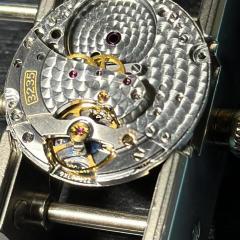Rolex cal. 1520
-
Similar Content
-
Recently Browsing
- No registered users viewing this page.
-
Topics
-
Posts
-
I believe @nickelsilver has a setup like that.
-
By LittleWatchShop · Posted
I posted pictures earlier in this thread. My lathe and mill are two separate instruments. I think I have seen examples of putting a milling head on a lathe bed...but not certain. -
Timex Camper, September 1994, new to me. Strap is an old perlon with "Germany" in script etched into the resin on the tail end. Not Horlon or Eulit I believe. History unknown, running strong, losing less than a minute a day. Goals for this: Wear it a ton! Buy crystal lift, clean out the gunk around the ring and under the crystal Eventually swap into a stainless steel case. I've seen a member who has swapped a Timex mechanical movement into the Timex J.Crew quartz field watch case.
-
One of the problems we would have with a watchmaker's lathe is they were made over considerable span of time and manufacturing in the early days probably wasn't as good as it was today. Then if you look at the older catalogs typically it was just the head a few collets and something to rest graver on. So basically a basic lathe with over time things acquired but acquired things may or may not fit. Order today you purchase a used lathe that all kinds of nifty bits and pieces from a seller that acquired from? This would come back to that the basic watchmaker's lathe was used for basic watchmaking like turning things with a hand graver. Then limited indexing is fine because you can make things like stems Which don't need a whole bunch indexing In the link above the word vector is mentioned and at the link below you can purchase one. Then of course you're going to need the motor that's a little bit extra for the price. https://www.hswalsh.com/product/lathe-vector-watchmakers-48-collets-hl11. That you're going to need some bonus parts like these found this picture online show the classic way of classic gear cutting. The lathe could have a much bigger indexing disk but it has to be mounted close to the edge. Otherwise you're going to have a whole bunch of smaller disks like this which I think has notches rather than holes. Then as wonderful as these pictures look actually cutting a gear with this is not entirely fun. Look at all is belts all pulling on things and this is a watchmaker's lathe lightweight with lots of bits and pieces attached. It would make more sense if you actually cut a gear with something like this and it tends to be it's not really the best way to do it looks nice on paper but it is not the best way to go. Reality for cutting watch parts would be a bigger machine is much better. Than getting rid of all those belts and pulleys also good. Here is an interesting channel I would've liked of found a different video but this was nice and short if you look at his video as he uses a stepping motor and worm gear assembly for the indexing plate. In this particular video it gets attached to the lathe at about one minute and seven seconds and it looks like it's hiding looks like he has a Sherline. I do know he's had other stuff you'll just have to go through his videos to find it. Then at about one minute and 22 seconds you find out if you set up things appropriately. It's always bad we end up with half a tooth at the very end. Then you will note big lathe yes he's getting a big gear but you could easily cut a watch gear with the setup. And it definitely way more stable than a watchmaker's lathe. Oh here's a company they been in business since 1911 http://www.fwderbyshireinc.com/
-
By RichardHarris123 · Posted
Hello and welcome from Leeds, England.
-









Recommended Posts